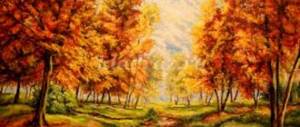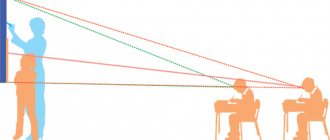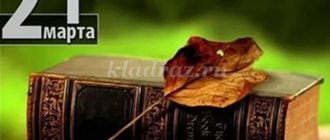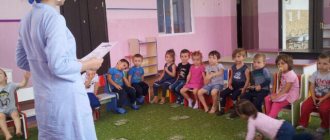Class progress
Teacher: Hello! Everyone probably knows the poems by S. Ya. Marshak “Good”
where we talk about good and bad. There is a lot of good in our life, but unfortunately, there is also a lot of bad. You've probably heard about bad habits and can you list them?
Children: Yes!
Alcohol; cigarettes; drugs.
Teacher: Correct. Today we’ll talk about one of these bad habits. About alcoholism and its harm. To make the lesson more interesting, let's play the next travel game. So let's begin.
Game No. 1
Teacher: Guys, imagine that you are astronauts who have received the task of flying around several planets and describing the life of aliens.
So, the first planet, the aliens happily greet you, calling you to see how they live, what they do and what they can do.
Picture No. 1: Children swim in the river, play volleyball, the sun is shining, a green meadow, a beautiful summer day.
Teacher: The main motto of this planet is “We want to be healthy!”
Look at the drawing. What are the habits of aliens on this planet? List them. (Only good habits are listed.)
Teacher: But, unfortunately, the time has come to say goodbye to the owners of the first planet, and the astronauts are flying to the next one.
Figure No. 2: A terrible city with dying nature, factory chimneys, bottles and cigarette butts scattered everywhere, the city is inhabited mainly by sick people.
Teacher: Look carefully at the following drawing of a planet. What do you see, do you like this planet? What are the habits of the inhabitants of this planet? Describe them. (Description of the appearance of the planet, the habits of the inhabitants.)
Figure No. 3: A planet with bottles and glasses scattered on its surface, a green serpent crawling out of the bottles, it has entangled all the inhabitants of the planet.
Teacher: And I’ll tell you a little about the third planet.
There was a drunkard on this planet. And the little cosmonaut who landed on this planet stayed with the drunkard for only a short time. But he was not at all happy. When the astronaut arrived on this planet, the drunkard sat silently and looked at the armies of empty and full bottles lined up in front of him.
- What are you doing? - asked the little astronaut.
“I’m drinking,” the drunkard answered gloomily.
- For what?
- To forget.
- What to forget? - asked the little astronaut. He felt very sorry for the drunkard.
“I want to forget that I’m ashamed,” the drunkard admitted and bowed his head.
- Why are you ashamed? - asked the little astronaut, he really wanted to help the poor guy.
- I'm ashamed to drink! - explained the drunkard, and it was impossible to get another word out of him.
And the little astronaut flew to Earth, confused and perplexed.
Teacher: Did you like this planet?
Children: No!
Teacher: What could you advise to the inhabitants of this planet?
Children: Stop drinking!
- Exercise!
- Make yourself true friends!
Teacher: Correct! After all, when a person starts drinking, he loses not only his health, but also his loved ones, friends and relatives.
Now let's talk about our planet, about our home.
What could our planet become if people do not give up bad habits and continue to destroy not only their health, but also the health of those around them?
Now draw our planet. Tell us about it, about its inhabitants and their habits. (Children draw.)
Teacher: Looking at your drawings, you can talk about them.
Children: I don’t want to not only get sick, but also live on a planet of sick people. But if each of us does not take care of our health, then our planet will not be healthy.
— Health is not only our strength, but also our mood, attitude towards ourselves and other people, the ability to live amicably and interestingly.
Teacher: Of the four planets, can you choose one on which you would like to live?
Children: We really liked the first planet. But we would still really like to live on our native Earth and make it more beautiful, cleaner and healthier.
Teacher: We found out and were convinced that alcohol is really harmful to humans. But bad habits are not only about drinking alcohol. There are many other harmful things that can prevent you from growing up healthy, beautiful, smart, surrounded by true friends and loved ones. But we must not forget about our helpers - good habits. But what more - good or bad - we can find out with the help of a game of balloons.
Game No. 2
There is a drawing on the board with the image of two balloons, inside which children can draw something that, in their opinion, brings harm or benefit to a person.
Teacher: Well done! From your drawings it is clear that there are many more good habits than bad ones. I am sure that none of you would like to be in the place of the drunkard from planet No. 3 or the inhabitants of the second planet. None of us wants to be alone, without friends, or sick and miserable. There is no place for alcohol and bad habits in our lives, because in our world there is so much good, kind, pure and bright.
The effect of alcohol on plant growth and development
Objectives: To familiarize schoolchildren with information about the harmful effects of alcohol on living organisms and plants; clearly demonstrate the effects of alcohol on plants.
Props: Plants in pots, samples of alcoholic beverages, plant grains.
Plan:
1. Introductory speech by the teacher.
2. Messages from schoolchildren who conducted the preliminary experiment.
3. Discussion with students about the results of the experiment.
“Using active methods in the classroom”
Message on the topic: “Using active methods in the classroom.”
The classroom hour is one of the most common forms of organizing frontal educational work that contributes to the formation of a system of relationships among students to the world around them.
The content of class hours is consistent with the educational program of the school and is conducted in 8 areas.
I use forms of conducting classroom hours according to the age of fifth-graders, taking into account their interests, needs and opportunities, in which students are involved in activities and reveal the given topic themselves.
Most of the class hours, of course where it is appropriate, I structure so that children work in groups, complete tasks in a playful way, solve problem situations, form certain concepts themselves, compare and comment, play out situations, and draw conclusions.
The form I always use is “Assignments and Reports.” This is a group of students who are given preliminary material and then presented in class.
During the preliminary preparation, there are no problems with who will participate: the students analyze the material with great pleasure. And those who themselves do not express a desire, but if I contact them, willingly agree. Thus, within 1 month the whole class will participate in class hours. And so on.
As well as game forms such as quizzes, competitions, and group work.
In accordance with the updated program of educational content in the classroom, we use Active Methods to maintain high cognitive activity of students to achieve the goals of the lesson, and AM is successfully used in the classroom.
AM puts the student in a new position when he ceases to be passive and becomes an active participant.
I pay special attention to the beginning of the class hour, which determines how actively the children get involved in work.
1. I start with a positive attitude, with exercise
"Let's say hello with our palms"
I say: - Let's wish each other health. Turn to each other, look into the eyes. Smile. Turn your palms towards each other, but do not touch, and connect your fingers with the words:
I wish (big)
Success (index)
Large(medium)
In everything (nameless)
Hello! (with the whole palm)
2. Method “Say hello with your eyes”
“-not with words, but silently with their eyes. At the same time, children show with their eyes what their mood is.
3.Method “Good in the palms”
Students put their hands together (as in the game “Ring-Ring”), “collecting” their goods in them and “passing” it to their neighbor.
When determining the topic of a class hour, I try to lead students to determine the topic ( Brainstorming method
)
-or I read a poem that contains key words,
-or offer quotes, statements,
-or riddles.
For example:
Try to determine the theme of this class hour.
“An evil witch snuck into our class and mixed everything up. See if everything is fine. (image of the sun. Words are written on the rays: hatred, rude, angry, greedy, sad, grief, enmity, deception, cruelty.
Let's fix everything. Choose antonyms for the words, and the sun will start smiling again.
Now try to determine the topic of the class hour. (Children's answers)
The theme of the class hour is “Good and Evil.”
Example:
The sentence is written: “A friend is someone who...”
The guys talk in a chain about who a friend is in their opinion and who they call their friends, then I invite the children to formulate their name for the class hour.
Example:
Quote from American writer Mark Twain:
“Kindness is something that the blind can see and the deaf can hear.”
-What is our class hour dedicated to?
Next, the children express their opinions about the concepts of kindness, a good person, evil, an evil person. Then we look at the explanatory dictionary, work in groups on tasks, the children collect proverbs
and in the end
- they make a daisy cluster -
they collect words that characterize a kind person.
Interview method
-I ask questions to hear students’ opinions on the topic under discussion.
When children work in groups, I use the “Keen Eye” method,
where students express their opinions while completing a task, offer their options, give their definitions and ultimately come to a common opinion
Also when working in groups
"The Hive Method"
where children discuss various problem situations.
"Final Circle Method" -
children stand in a circle and ask questions in a circle about what they learned in class. I also use this method for the Association of keywords in the class topic.
For example:
Leader, President, Independence, Kazakhstan, friendship, family, Internet.
(students speak in a circle)
Conclusion:
It is not necessary to use AM at every class hour. There are classroom hours that involve conversation, storytelling, or simply contain information. The use of AM is interesting not only for students, but also for teachers. But it is important to develop and implement them in classroom hours in accordance with individual features of its class. The world of AM is bright, amazing, multifaceted. Both teachers and students feel comfortable in it. Therefore, we will discover its secrets and possibilities, we will learn to manage its powerful potential, we will make our work much more interesting and effective, and our students grateful and happy.
3
Progress of educational work
Three to four months before the expected date of class, schoolchildren are divided into 2 groups and carry out experimental work.
Experiment No. 1. The effect of alcohol on plant shoots
Take four flower pots, fill them with the same soil and plant a pea grain (or other legumes, or seeds from pome plants)
.
The first pot is watered with water, the second with beer, the third with grape wine and the fourth with vodka. After a few days, the pea grain in the first pot (which is watered)
begins to sprout and lift the soil cover. In the other three, nothing happens. Watering with four different liquids continues. After some time, the grain, watered with water, appears outside; watered with beer begins to sprout; When watered with grape meme, it begins to swell. After two weeks, the first grain produces nice little leaves; the rest of the grains do not even show out yet. From the 15th day, all the pots are watered, and soon the second and third grains also appear, although belated and pitiful in appearance. The fourth and last pea grain, which was watered with vodka, does not appear from the ground at all, since it is practically killed.
Experiment No. 2. The effect of alcohol on the rate of plant germination
Take several glass flat containers. The containers are filled according to the following principle: in the first container - clean water, in the last - pure alcohol. The remaining containers are filled with liquid with different alcohol concentrations. You can take 4 containers: water, 33% alcohol, 66% alcohol, pure alcohol; or 6 containers: water, 25% alcohol, 50% alcohol, 75% alcohol, pure alcohol. Then ten pea grains are placed in each glass container so that they are half immersed in liquid. After four days, they begin to observe the grains: how they swell, how they germinate, determine the length and branching of the roots, the length, strength of the shoots, etc. Schoolchildren must make sure that all ten grains germinate in clean water, the roots reach their greatest length and branching, and the shoots are the longest and strongest. The higher the percentage of dissolved alcohol in the liquid, the longer the peas take to germinate, the roots are shorter and thinner, and the shoots are stunted. In stronger solutions, the roots do not show a tendency to branch; shoots appear much later. After a month, pea grains1 rot in containers with strong alcohol solutions. The leaves and fruits bear pea grains, found only in water and in liquids with a small amount of alcohol. In the rest, they dry out before they can produce leaves.
Schoolchildren carry out these experiments , record their observations in a separate observation diary, then conduct an analysis and draw conclusions.




